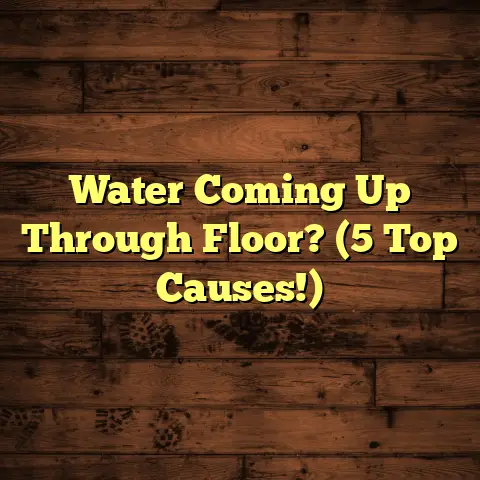Hardwood Floor Care (3 Mistakes Costly!)
And believe me, nothing breaks my heart more than seeing a beautiful hardwood floor ruined by easily avoidable mistakes.
We all want our homes to look their best, right?
That’s where the idea of future-proofing comes in – taking steps now to protect your investment for years to come.
And when it comes to investments, hardwood floors are a classic choice.
They add warmth, elegance, and value to any home.
But here’s the thing: hardwood floors aren’t invincible.
They need proper care to maintain their beauty and last a lifetime.
Unfortunately, many homeowners unknowingly make costly mistakes that can lead to significant damage and expensive repairs.
I’m talking about issues like cupping, gapping, finish damage, and even the need for complete replacement.
Trust me, I’ve seen it happen far too often.
That’s why I’m writing this article – to help you avoid these pitfalls and keep your hardwood floors looking their best for years to come.
I’m going to walk you through three critical mistakes that I see homeowners making all the time.
We’ll dive deep into each one, exploring the causes, the consequences, and, most importantly, how to avoid them.
Ready to learn how to future-proof your hardwood floors? Let’s get started!
Mistake #1 – Neglecting Regular Maintenance
Okay, let’s be real: cleaning isn’t anyone’s favorite chore.
But when it comes to hardwood floors, regular maintenance is absolutely essential.
Think of it like this: you wouldn’t skip oil changes on your car, would you?
The same principle applies to your floors.
Neglecting regular maintenance can lead to a buildup of dirt, debris, and grime that can damage the finish and the wood itself.
I’m talking about scratches, dullness, and even permanent stains.
So, what exactly does “regular maintenance” entail?
Well, it’s more than just a quick sweep every now and then.
It involves establishing a consistent cleaning routine and taking protective measures to prevent damage in the first place.
Let’s break it down:
The Culprits: Dirt and Debris
Over time, all sorts of nasties can accumulate on your hardwood floors.
We’re talking about:
- Dust and dirt: Carried in on shoes, blown in through windows, and just generally floating around.
- Pet hair: If you have furry friends, you know the struggle is real.
- Sand and grit: These tiny particles act like sandpaper, scratching the finish with every step.
- Spills and splatters: Accidents happen, but if left unattended, they can cause stains and damage.
These seemingly harmless substances can wreak havoc on your floors over time.
The constant abrasion from dirt and grit wears down the finish, making it dull and susceptible to scratches.
Spills can seep into the wood, causing discoloration and even warping.
And pet hair? Well, let’s just say it can trap dirt and moisture, creating a breeding ground for bacteria. Yuck!
The Cleaning Arsenal: Techniques and Products
So, how do you combat these threats?
The key is to establish a regular cleaning routine using the right techniques and products.
Here’s my recommended approach:
-
Daily Sweeping or Vacuuming: This is your first line of defense. Use a soft-bristled broom or a vacuum with a hardwood floor attachment to remove loose dirt and debris. I recommend doing this daily, especially in high-traffic areas.
-
Weekly Damp Mopping: This will remove any remaining dirt and grime. But be careful! Too much water can damage hardwood floors. Use a microfiber mop and a hardwood floor cleaner specifically designed for your floor’s finish. Wring out the mop thoroughly so it’s damp, not soaking wet.
-
Spot Cleaning: Accidents happen, so be prepared to clean up spills immediately. Use a soft cloth and a pH-neutral cleaner to blot the spill. Avoid rubbing, as this can spread the stain.
Now, let’s talk about products. Not all cleaning products are created equal, and some can actually harm your hardwood floors.
Avoid these like the plague:
- Harsh Chemicals: Ammonia, bleach, and other harsh chemicals can strip the finish and damage the wood.
- Abrasive Cleaners: These can scratch the finish and leave a dull residue.
- Steam Mops: While they might seem convenient, steam mops can force moisture into the wood, causing warping and other issues.
- Oil Soaps: These can leave a sticky residue that attracts dirt and makes your floors look dull.
Instead, opt for products specifically designed for hardwood floors.
Here are some of my go-to recommendations:
- Bona Hardwood Floor Cleaner: This is a popular and widely available option that’s safe for most hardwood finishes.
- Murphy Oil Soap: When diluted properly, Murphy Oil Soap can be a gentle and effective cleaner. However, be sure to follow the instructions carefully to avoid leaving a residue.
- Vinegar and Water Solution: A simple solution of 1/4 cup of white vinegar per gallon of water can be a safe and effective cleaner for some hardwood floors. However, test it in an inconspicuous area first to make sure it doesn’t damage the finish.
The Timeline: How Often to Maintain
So, how often should you be performing these maintenance tasks?
Here’s my recommended timeline:
- Daily: Sweep or vacuum high-traffic areas.
- Weekly: Damp mop the entire floor.
- Monthly: Inspect for scratches, dents, and other damage.
- Every 3-5 Years: Consider refinishing to restore the finish and protect the wood.
Of course, this is just a general guideline.
The frequency of maintenance will depend on your lifestyle, the amount of traffic your floors receive, and the type of finish you have.
For example, if you have pets or young children, you may need to clean more frequently.
And if you have a high-gloss finish, you may need to polish it more often to maintain its shine.
The Horror Stories: Neglect Gone Wrong
I’ve seen firsthand the consequences of neglecting regular maintenance.
I remember one client who had beautiful oak floors in her living room.
She loved the look of them but admitted she rarely cleaned them, figuring a quick sweep every few weeks was enough.
Over time, the floors became dull and scratched.
Dirt and grime had embedded themselves in the finish, making them look dingy and worn.
When I finally convinced her to have them professionally cleaned and refinished, the cost was significantly higher than it would have been if she had simply maintained them properly in the first place.
Another client had a dog that loved to run around the house.
Unfortunately, the dog’s nails scratched the floors, and the client never bothered to trim them or put down rugs.
Eventually, the scratches became so deep that the floors needed to be completely replaced.
These are just two examples of how neglecting regular maintenance can lead to costly consequences.
Don’t let it happen to you!
Mistake #2 – Ignoring Environmental Factors
Now, let’s talk about something that many homeowners overlook: the impact of environmental factors on hardwood floors.
I’m talking about things like humidity, temperature fluctuations, and sunlight exposure.
These factors can have a significant effect on the health and appearance of your floors, and ignoring them can lead to some serious problems.
Trust me, I’ve seen it all: warped boards, cracked finishes, and even complete floor failures.
Wood is a natural material, and it’s constantly responding to changes in its environment.
One of the most significant ways it does this is through expansion and contraction.
When the humidity is high, wood absorbs moisture from the air and expands.
When the humidity is low, wood releases moisture and contracts.
These changes in size can put stress on the floor, leading to gaps, warping, and other issues.
Think of it like this: imagine a rubber band stretched tightly between two points.
If you heat the rubber band, it will expand and become looser.
If you cool it, it will contract and become tighter.
The same thing happens with wood, but instead of temperature, it’s humidity that’s the primary driver.
The ideal humidity level for hardwood floors is between 30% and 50%.
When the humidity falls outside of this range, problems can start to occur.
The Consequences: Gaps, Warping, and More
So, what happens when you neglect these environmental factors?
Here are some of the most common consequences:
- Gaps: When wood contracts, gaps can appear between the boards. These gaps can be unsightly and can also trap dirt and debris.
- Warping: When wood expands and contracts unevenly, it can warp or cup. Warping can make the floor uneven and can also damage the finish.
- Cracking: Extreme changes in humidity can cause the wood to crack, especially in areas where the floor is already stressed.
- Finish Damage: High humidity can cause the finish to bubble or peel. Low humidity can cause the finish to become brittle and crack.
These problems can be costly to repair, and in some cases, they may even require complete floor replacement.
The Solutions: Managing Humidity and Temperature
So, how do you protect your hardwood floors from these environmental threats?
Here are some strategies for managing humidity and temperature in your home:
-
Use a Humidifier or Dehumidifier: Depending on your climate, you may need to use a humidifier or dehumidifier to maintain the ideal humidity level in your home. A humidifier adds moisture to the air, while a dehumidifier removes moisture.
-
Maintain a Stable Temperature: Avoid extreme temperature fluctuations in your home. This means keeping the thermostat set at a consistent temperature, even when you’re away.
-
Improve Ventilation: Good ventilation can help to regulate humidity levels in your home. Make sure your bathrooms and kitchens are properly ventilated, and open windows when the weather permits.
-
Insulate Your Home: Proper insulation can help to maintain a stable temperature and humidity level in your home.
-
Acclimate the Wood: If you’re installing new hardwood floors, be sure to acclimate the wood to your home’s environment before installation. This means allowing the wood to sit in your home for several days to adjust to the temperature and humidity.
The Power of Protection: Area Rugs and Window Treatments
In addition to managing humidity and temperature, there are other steps you can take to protect your hardwood floors from environmental damage.
One of the most effective is to use area rugs.
Area rugs can protect your floors from UV damage, direct sunlight, and scratches.
They can also help to insulate the floor and reduce noise.
When choosing area rugs, be sure to select ones that are made of natural materials, such as wool or cotton.
Avoid rugs that are made of synthetic materials, as these can trap moisture and damage the finish.
Another important step is to use window treatments.
Window treatments can block out sunlight and reduce the amount of UV radiation that reaches your floors.
They can also help to insulate your home and reduce energy costs.
Consider using blinds, curtains, or shades to protect your floors from the sun.
The Real-Life Disasters: Environmental Neglect in Action
I’ve seen some pretty disastrous cases of environmental neglect over the years.
I remember one client who lived in a coastal area with high humidity.
She never used a dehumidifier, and her hardwood floors started to warp and buckle.
Eventually, the floors had to be completely replaced.
Another client had a large, south-facing window in her living room.
The sun streamed in all day long, and the floors started to fade and discolor.
She never used window treatments, and the damage was irreversible.
These are just two examples of how environmental neglect can lead to costly consequences.
Don’t underestimate the power of humidity, temperature, and sunlight!
Mistake #3 – Choosing the Wrong Products
Alright, let’s get down to the nitty-gritty of floor cleaning products.
This is where a lot of homeowners go wrong, often with disastrous results.
I can’t tell you how many times I’ve seen floors damaged by well-intentioned people using the wrong cleaners or waxes.
It’s a common misconception that all floor cleaning products are suitable for hardwood.
That couldn’t be further from the truth!
In fact, some products can actually harm your floors, stripping the finish, leaving residues, or even causing permanent damage.
The Product Pitfalls: What to Avoid
So, what types of products should you avoid?
Here’s a list of the most common offenders:
-
Wax-Based Cleaners: These can leave a waxy buildup that dulls the finish and attracts dirt. They can also make it difficult to refinish the floors later on.
-
Oil Soaps: Similar to wax-based cleaners, oil soaps can leave a residue that attracts dirt and makes your floors look dull.
-
Abrasive Cleaners: These can scratch the finish and leave a dull residue. Avoid using scouring pads, steel wool, or any other abrasive cleaning tools.
-
Ammonia-Based Cleaners: Ammonia can strip the finish and damage the wood.
-
Bleach: Bleach can discolor the wood and damage the finish.
-
Vinegar: While diluted vinegar can be used on some hardwood floors, it’s not always the best choice. Vinegar is acidic and can damage the finish over time.
-
Steam Mops: Steam mops can force moisture into the wood, causing warping and other issues.
The Safe Zone: Recommended Products
Now that we’ve covered what to avoid, let’s talk about what you should be using on your hardwood floors.
Here’s my recommended list of products that are safe and effective:
-
pH-Neutral Hardwood Floor Cleaners: These cleaners are specifically designed for hardwood floors and won’t damage the finish. Look for products that are labeled as “pH-neutral” or “safe for hardwood floors.” Bona is a popular and widely available brand.
-
Microfiber Mops: These mops are gentle on hardwood floors and won’t scratch the finish. They’re also very effective at picking up dirt and debris.
-
Dust Mops: These mops are great for removing loose dirt and dust from your floors.
-
Floor Polish: If you want to add a little shine to your floors, you can use a floor polish specifically designed for hardwood floors. Be sure to follow the instructions carefully and avoid using too much polish.
The Label Lowdown: Reading and Understanding
One of the most important things you can do to protect your hardwood floors is to read the labels on cleaning products carefully.
Pay attention to the ingredients and look for products that are specifically designed for hardwood floors.
Avoid products that contain harsh chemicals, abrasives, or waxes.
If you’re not sure whether a product is safe for your floors, test it in an inconspicuous area first.
Apply a small amount of the product to a hidden spot, such as under a rug or in a closet.
Wait 24 hours and then check to see if the product has damaged the finish.
The Horror Stories: Product Mishaps
I’ve seen some pretty bad product mishaps over the years.
I remember one client who used a wax-based cleaner on her hardwood floors.
Over time, the wax built up and made the floors look dull and dingy.
She tried to remove the wax with a variety of cleaners, but nothing worked.
Eventually, she had to have the floors professionally stripped and refinished.
Another client used an ammonia-based cleaner on her floors.
The ammonia stripped the finish and damaged the wood.
The floors had to be completely replaced.
These are just two examples of how using the wrong products can lead to costly consequences.
Don’t take chances with your hardwood floors!
Conclusion
So, there you have it: the three most costly mistakes homeowners make when caring for their hardwood floors.
Let’s recap:
- Neglecting Regular Maintenance: A little bit of sweeping and mopping goes a long way.
- Ignoring Environmental Factors: Humidity, temperature, and sunlight can wreak havoc on your floors.
- Choosing the Wrong Products: Not all floor cleaners are created equal.
By avoiding these mistakes, you can future-proof your hardwood floors and keep them looking beautiful for years to come.
Remember, proper maintenance, awareness of environmental factors, and the use of appropriate products are all essential for the long-term health and beauty of your floors.
Now, I want you to take a good look at your current hardwood floor care practices.
Are you making any of these mistakes?
If so, don’t worry! It’s never too late to make adjustments.
Start by establishing a regular cleaning routine, managing humidity and temperature in your home, and using the right products.
With a little bit of effort, you can avoid these common pitfalls and enjoy your hardwood floors for many years to come.
So, go ahead and take action today.
Your floors will thank you for it!





